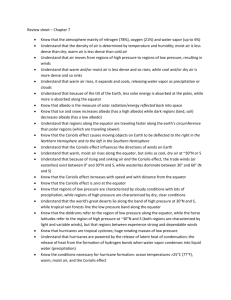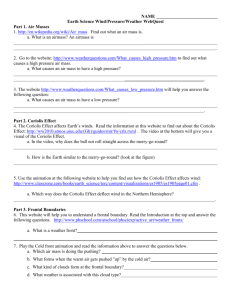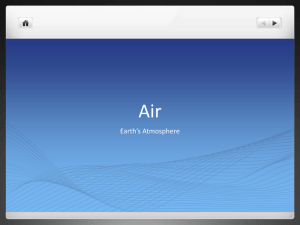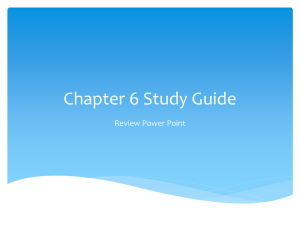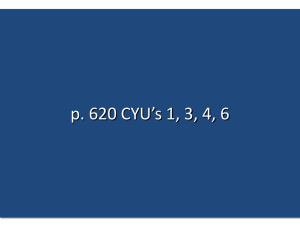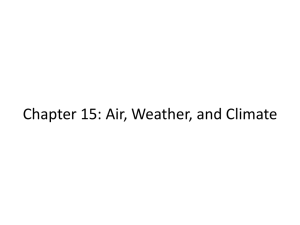Meteorology & Climate
advertisement
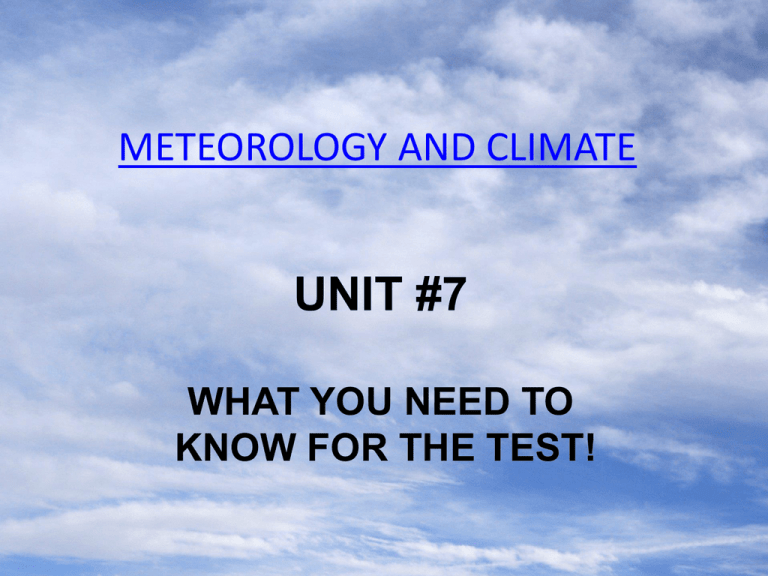
METEOROLOGY AND CLIMATE UNIT #7 WHAT YOU NEED TO KNOW FOR THE TEST! Cloud Formation Vocabulary • Absolute humidity – actual amount of water in the air at that temperature • Condensation nuclei – air particles of dust or salt from the ocean • Convection – transfer of heat energy by currents • Density – mass per unit volume of a substance • Dew point – temperature at which condensation occurs • Sublimation – change of phase from solid to gas (or gas to solid) with no intermediate liquid phase • Troposphere – lowest layer of the atmosphere where all weather occurs Weather instruments measure weather conditions. One of the most important conditions is air pressure, which is measured with a barometer, shown below. See the other commonly used weather instruments: Rising air pressure = fair weather Falling air pressure = foul weather •Thermometer measures temperature. •Anemometer measures wind speed. •Rain gauge measures the amount of rain. •Hygrometer measures humidity. •Wind vane shows wind direction. •Snow gauge measures the amount of snow. Change of Phases – Heat Energy ESRT pg. 1 If something is getting warmer (increased temperature), heat energy is gained. If something is getting cooler (decreased temperature), heat energy is released. HEAT TRANSFER How is heat transferred in the atmosphere? Radiation, Conduction, Convection HEAT TRANSFER BY CONVECTION Local breezes are generated by unequal heating of Earth’s surface due to local conditions Warm, less dense air is pushed upward, while more dense, cool air descends, creating a SEA BREEZE during the day (sea to land) Cool, more dense air descends, while warm, less dense air is pushed upward, creating a LAND BREEZE at night (land to sea) SPECIFIC HEAT The quantity of heat, measured in joules, needed to raise the temperature of 1 gram of a substance 1o C. The higher the specific heat of a substance, the greater amount of heat needed to raise its temperature. If a substance requires more heat to “heat up”, it will take longer for it to heat up, which means it will also take longer for it to “cool down”. ESRT pg. 14 Temperature Scale ESRT pg. 14 REMEMBER:The dry bulb is the air temperature. The wet bulb is swung in the air as water evaporates, removing heat from the bulb of the thermometer, which causes the temperature to be lower (cooler). *The closer the air temperature and dewpoint temperature, the higher the relative humidity (precipitation!). PRACTICE QUESTIONS ADIABATICISM (OROGRAPHIC EFFECT) Dry lapse rate: 10o Moist lapse rate: 6o --Dry lapse rate occurs between the land surface and the base of cloud (dew point)—as air ascends, altitude increases/temperature decreases. --Moist lapse rate occurs from dew point to the top of the cloud—as altitude increases/ temperature continues to decrease. --From the mountain peak air descends back down to the land surface— as altitude decreases, temperature increases, and the dry lapse rate continues again down to the base of the mountain at Earth’s surface. STATION MODELS ESRT pg. 13 Altitude and Air Pressure Higher up in elevation, there is less air above so the air pressure decreases. At the surface of the Earth the air pressure is greater because there is more air above you! Density and Air Pressure More molecules, packed tightly together The lower the air density, the lower the air pressure! Higher weight per volume The higher the air density, the higher the air pressure! Fewer molecules, spread out. Lower weight per volume Temperature and Air Pressure Cold air is more dense! As air temperature decreases, air pressure increases! High Pressure! H Low Pressure! As air temperature increases, air pressure decreases! L Warm air is less dense! The wind blows because air has weight! 1) Cold air weighs more than warm air, so the pressure of cold air is greater. Low Pressure! High Pressure! H 2) When the sun warms the air, it expands, gets lighter, and rises. 3) Cooler, heavier air blows to where the warmer and lighter air was. L CORIOLIS EFFECT The Coriolis Effect is the apparent curvature of global winds, ocean currents, and everything else that moves freely across the Earth’s surface. The Coriolis Effect is due to the rotation of the Earth on its axis. If not for the Earth’s rotation, global winds would blow in straight north-south lines. What actually happens is that global winds blow diagonally. The Coriolis Effect influences wind direction around the world in this way: in the Northern Hemisphere it curves winds to the right; in the Southern Hemisphere it curves them left. The exception is with low pressure systems. In these systems there is a balance between the Coriolis Effect, and the pressure gradient force and the winds flow in reverse. To sum up ‘what is the Coriolis Effect’-- it is an important meteorological force that is used to predict the directional path of storms. http://www.youtube.com/watch?v=mcPs_OdQOYU AIR MOVEMENT Coriolis Effect is the deflection of air near Earth’s surface caused by Earth’s rotation. N. Hemisphere S. Hemisphere A wind is named for the direction from which it comes! Westerly Wind PRESSURE GRADIENT FORCE The change in pressure measured across a given distance is called a “pressure gradient”. The higher the force, the faster the wind speed. As an air parcel moves from high pressure to low pressure because of the pressure gradient force, it is deflected by the Coriolis force to the right in the Northern Hemisphere. On which side of the hill is the greatest wind speed, and why?... The wind blows fastest on the left side where the isolines are closest together. This is where the greatest change is. Weather Fronts - A weather front is a boundary separating two masses of air of different densities. Symbol Front Warm Front -- A warm front is defined as the transition zone where a warm air mass is replacing a cold air mass. Cold Front -- A cold front is defined as the leading edge of a cooler mass of air, replacing (at ground level) a warmer mass of air. Stationary Front -- is a boundary between two different air masses, neither of which is strong enough to replace the other. PRECIPITATION occurs right at the cold front and ahead of the warm front The COLD air mass front is steep and the WARM air mass front is more gentle. *NOTE: that the cold, heavier air mass, is associated with HIGH PRESSURE, is typically below the lighter, less dense warm air. YOU NTK THIS!!! SYNOPTIC WEATHER MAP WET moisture belt = warm, converging air rising DRY moisture belt = cool, divergent air sinking CLIMATE PATTERNS CLIMATE is the average temperature and amount of precipitation for an area over a long time (annually). Compared to the climate at location A, the climate at location B would most likely be WARM (sinking, compressed air) and DRY (low humidity, away from moisture source)—desert region. FACTORS INFLUENCING CLIMATE • Latitude • Altitude • Mountain ranges • Oceans/lakes • Ocean currents • Landmass location • Arid air – dry • Humid air – moist Climate types: • *Arctic – very cold, dry • Polar – cold, moist • Temperate – varied temperatures (4 seasons) • *Tropical – warm, humid *(little seasonal change)


